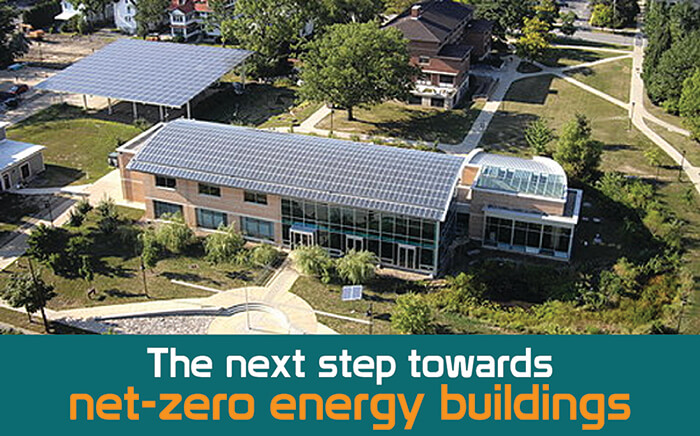THE NEXT STEP TOWARDS NET-ZERO ENERGY BUILDINGS
 13-Apr-2022
13-Apr-2022The Next Step Towards Net-Zero Energy Buildings If you aren't already aware, the United States has a plan to make all buildings net-zero energy by the year 2030. What does this mean? Well, in simple terms, that means that buildings will be energy efficient and won't have to use backup power to function. Read more to find out how buildings are doing this.
Buildings that use less energy are great for the environment, but there is always room for improvement. A net-zero energy building is a building that doesn't use any energy from the power company. This is a great step in the right direction towards an environmentally friendly planet.
HOW THEY ARE BUILT
Many cities, states, and countries are committed to reducing their environmental impact by using less energy, but what is the next step for this commitment? A new level of achievement for net-zero energy buildings. Net-zero energy buildings are in the final stages of development in countries in Europe and North America, in addition to many other countries in Asia. These buildings are the next step towards the efficiency of energy production and use, in addition to reducing the negative environmental effects on the planet. Net-zero energy buildings use substantially less energy than average buildings, thanks to improved building design. Energy is harvested from renewable sources such as solar, wind, and geothermal power. Energy captures are integrated into the building’s design.
Read More: 10 Ways to Welcome the Positive Vibes at Home
HOW THEY ARE MADE MORE EFFICIENT
With new construction and renovations of existing structures, energy efficiency is the name of the game. The US building industry has been on a mission to reduce energy consumption and carbon emissions. With this mission in mind, new net-zero energy buildings are on the rise. While some might expect net-zero buildings to be prohibitively expensive, the reality is that these buildings boast more and more affordable and efficient features and amenities than ever before. The buildings we live and work in today demand more and more of our money and time. But builders, owners, and developers of net-zero buildings are taking a new approach that equates to saving money and energy.
WHAT THE FUTURE HOLDS
The next step towards net-zero energy buildings: What the future holds Every new building built in the United States is required to meet the latest ASHRAE Standard 90.1©, which means that they should be capable of heating and cooling themselves without any outside sources or mechanical systems. The result of this is a building that relies on renewable energy and new technologies to heat and cool without using fossil fuels and natural gas. The future of buildings will rely on plentiful renewable energy and new technology like the use of windows and windows frames that are designed for maximum daylighting. Buildings will also be made to be more efficient. These buildings will use fewer natural resources, use less electricity, and cause less indoor pollution.
- Buildings that produce extra strength than they consume
- Buildings that produce less energy than they consume
- Buildings that produce the identical quantity of power as they consume
- Buildings that eat greater strength than they produce
- Houses that produce greater strength than they consume
- Houses that produce less energy than they consume
- Houses that produce the same amount of energy as they consume
- Houses that eat greater strength than they produce
- Houses that produce more energy than
WHAT IS A NET-ZERO-ENERGY BUILDING?
Net-Zero-Energy Buildings Recently, I’ve been thinking about the advantages of net-zero-energy buildings. Many buildings have been built to be ‘net-zero’, meaning that their energy footprint is neutral, meaning that the buildings produce as much energy as they consume. Recently, more buildings are aiming to be net-zero. These buildings are usually equipped with solar panels on the roof, onsite renewable sources of energy, heat pumps or geothermal heat pumps, co-generation equipment, onsite fuel cells, and more. Not only are net-zero-energy buildings beneficial for the environment, but they are also great for the inhabitants
Read More Article:- Positive Energy Home Décor
WHAT DOES IT TAKE TO GET THERE?
In recent years, the goal of net-zero energy buildings has been looming large to reduce energy consumption, emissions, and other harmful environmental impacts. What would it take for a building to be net-zero? Earlier this year, Buildings Magazine hosted a roundtable on "The next step towards net-zero energy buildings: What does it take to get there? "Building scientists and agency professionals revealed the glorious reign of NetZero power plants, aiming to answer the question: what does it take to get there?" The first stage in creating a net-zero energy building is to design the building envelope, which is meant to operate well and eliminate energy waste.
“Net-zero energy buildings are more than just an environmental trend - they’re essential for sustainable building development. Net-zero buildings are put through rigorous energy audits before construction, resulting in more energy-efficient buildings. There are more than 7 million buildings in the US that are rated as “energy inefficient”, with some buildings consuming as much as 17 times more energy than others.”
We are provided the rental flats in Noida. So, can visit your site and contact us.
Related Article: Top Ways To Save Home Energy



